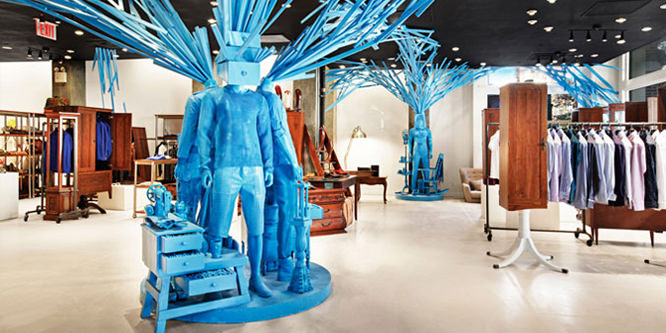
Photo: Public.Factory
Public.Factory’s co-retailing concept gives start-ups a leg up
With the opening last fall of its first location at the SoHo Grand hotel in NYC, Public.Factory declared itself to be the first company taking the sharing economy to the retail world.
The startup, which has since opened a second location in SoHo and will open a third in San Francisco’s Union Square this year, leases large spaces and subdivides them for short-term rental to emerging designers and entrepreneurs.
The concept came to Founder Yazid Aksas, who owns the menswear label, Beau.com, after he experienced his own challenges opening a store on West Broadway. Requirements often include a ten-year lease, 12-month deposit and add-on construction and design costs.
Working much like WeWork, the co-working collaboration space, renters at the SoHo Grand pay a monthly fee of $3,000 for about 100-square-feet of space. The “Plug & Sell” solution provides spots that are fully set-up and ready to use, covering furniture, fixtures, electricity and other basic costs, and even provides a sales staff. Renters must commit to at least three months but can renew indefinitely. A brand can pull out with one-month’s notice.
Public.Factory writes on its website, “This turnkey solution is every brand’s dream. A dream where they only have to focus on product and marketing to grow their business.”
The SoHo Grand hotel, which filled all its spots two months before opening, features 12 men’s wear labels, including Beau.com. The second SoHo location focuses on 16 upcoming women’s fashion and beauty start-ups, while the San Francisco space will stock 20 tech brands.
Renters also benefit from the traffic heading to other brands in the space. The community of brands can collaborate on marketing and PR initiatives, including hosted events.
“My vision is to enable any brand to have a retail presence anywhere in the world,” wrote Mr. Aksas on his blog. “And I want that to happen within a couple of days for less than what it would cost them to open one store on their own.”
- Public.Factory
- Yazid Aksas Blog
- A WeWork for young fashion designers to debut in SoHo – Crain’s New York
- Spotlight: Public.Factory Offers Co-Retailing Space for Brands – Small Business Trends
- Young Designers Who Can’t Afford Retail Rents Now Have a Store of Their Own – Racked.com
- Co-Retailing Menswear Space Public Factory To Launch Shoppable Website – Fashion Times
See more photos in our Facebook album (courtesy of Gene Detroyer)
Discussion Questions
DISCUSSION QUESTIONS: Does the Public.Factory shared space model have legs? What do you see as the upside and downside for renters and shoppers?


Against the backdrop of supporting the community and buying locally, this variation on the sharing economy will find a home.
Renters have a lower cost hurdle to gain access to customers who can find multiple shops with unique products within a common space. Scalability (and growth) operates on the real estate level rather than at the store or shop level.
Good space for a spin up — but the key for retail stores is location. Some goods or creations fit SoHo and others do not. Using this space to refine the store element of the retailing process is smart — the key is to be ready to move it to better locations based on product. Not all people are “SoHo hip.”
It’s a brilliant idea IF …
This co-op model has been tried with all kinds of products including one in home decor and furnishings near my home. It didn’t take long for the initial enthusiasm to die. None of the participants seemed willing to work it.
So the “IF” is fourfold. 1. IF the renters are vetted to ensure that they are prepared to make more than the financial investment. That’s the easy part. For example, investing in personal passion and energy, quality, variety and availability of product, customer service, attentiveness, etc. 2. IF the renter keeps their section refreshed and interesting. 3. IF the principals actually participate in this collaborative community. That means becoming familiar and friendly with fellow renters in order to make meaningful referrals to them. If you’re selling dresses you tell the customer where they can get the perfect belt and necklace. 4. IF every renter is a truly nice person regardless of how well sales are doing. One miserable, angry or discouraged vendor can ruin the whole place.
I too love the concept but your Ifs are spot on!
I believe that the share space model works in a location that is its own destination. Then all the brands can benefit from exposure to consumers who show up at that address. There’s no way to forecast the compatibility of the brands or the entrepreneurs, but brands and product on display is what potential customers want to see. It’s up to Public.Factory to set guidelines that support their customers to win over new and repeat purchasers. I think it’s a great opportunity for renters to control their overhead at the beginning of their marketplace entry…when it’s so important. For shoppers it will be a question of seeing merchandise that appeals and ultimately ends up in their home. That’s the job of the brand, product, price and promotion.
If Public.Factory expects shoppers to seek out Public.Factory, I think the challenge will be daunting at the least. I think Public.Factory has to make it easy for customers to stumble upon their retail locations. And that’s why I believe pre-existing destinations are critical. That can include shopping malls, high traffic strip malls and urban locations that generate high traffic.